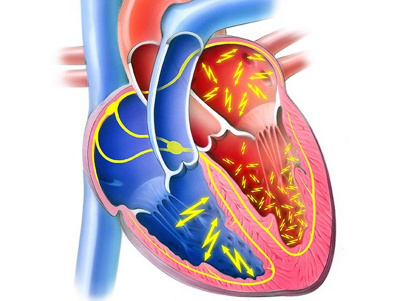Patients with atrial fibrillation notice symptoms such as rapid heartbeat, heart palpitations, or irregular pulse. Irregularities and skipped beats are normal to a certain extent. However, if the symptoms become more frequent, it is worth consulting a doctor.

A healthy heartbeat is regular, variable, occurs unconsciously and feels like a pulse wave throughout the body. The rhythm is usually determined by an electric impulse produced by the sinus node in the right atrium of the heart and it reacts quickly to physical exertion or emotional and psychological factors. This is known as the sinus rhythm.
Atrial fibrillation – Uncontrolled heart rhythm
Atrial fibrillation causes the sinus rhythm to be disrupted by erratic electrical impulses. The heart goes haywire, beating in an irregular and uncoordinated manner. The sinus node fibrillates and the AV node, which usually only transmits the regular electrical impulses from the atriums to the ventricles, starts dictating the rhythm of the heart’s chambers. This causes the heart’s activity to become irregular and disconnected from any physical exertion or emotions, so that it no longer adapts to the needs of the body. The atriums beat up to 350 times a minute, while the ventricles beat between 60 and 130 times a minute.
Older people are more frequently affected
Atrial fibrillation is usually caused by unusual triggers in the transitional tissue between the pulmonary veins and the left atrium. It can also be caused by tissue changes (fibrosis) in the atriums of the heart, which can hinder the transmission of the heart’s electrical impulses in the atriums. These tissue changes are typically age-related, however they can also be promoted by disorders such as high blood pressure, heart-related illnesses, excess body weight, diabetes, renal insufficiency, an over-active thyroid, sleep apnoea, alcohol, etc.
Around one percent of 60-year-olds are affected by atrial fibrillation. For the over 85-year-olds, that figures increases to 20 percent. When younger people experience atrial fibrillation, it is often a symptom of some other heart valve disorder. Such cases should always be checked by a specialist.
Prompt treatment makes all the difference
People with atrial fibrillation are five times more likely to suffer a stroke. The irregular heart activity can cause blood clots to form in the heart’s left auricle, which are then distributed throughout the body and may block smaller arteries. In the brain, this can lead to the much-dreaded stroke. If the irregular heartbeat is ongoing, over time this can also result in cardiac insufficiency (heart failure). That is why untreated atrial fibrillation leads to increased mortality, hospital admissions and, of course, reduced quality of life.
Three kinds of atrial fibrillation
Depending on when the condition arises, how long it lasts and whether it can be reversed, it is referred to as either paroxysmal, persistent or permanent atrial fibrillation.
1. Paroxysmal atrial fibrillation
Paroxysmal atrial fibrillation is self-limiting and hardly noticeable. It usually comes and goes by itself. Patients normally have a sinus rhythm and the fibrillation only occurs sporadically. However, it can also show very pronounced symptoms.
2. Persistent atrial fibrillation
The development of persistent atrial fibrillation is more complex and the heart usually does not resume a normal sinus rhythm by itself. A sinus rhythm can however be restored by means of a ‘conversion’, which involves various medications or interventions.
3. Permanent atrial fibrillation
Permanent atrial fibrillation can no longer be reversed. It is only possible to treat the resulting complications, so for instance patients are given blood thinning medication to prevent strokes and their heart rate is monitored to prevent an excessively fast heartbeat.
Find out more about the possible treatments in the second part of this blog post
More information about cardiovascular health and heart surgery is available from Heart Clinic Hirslanden.
Article from PD Dr. med. Sacha P. Salzberg, specialist in cardiothoracic vascular surgery at Heart Clinic Hirslanden.
